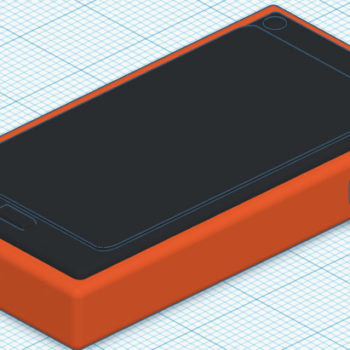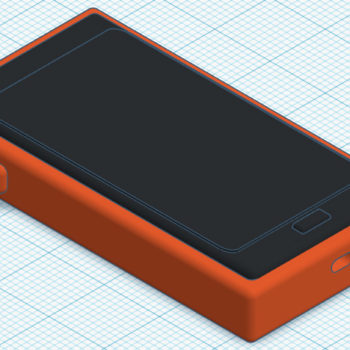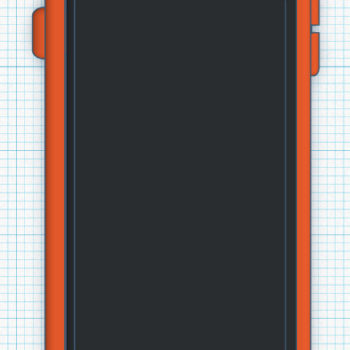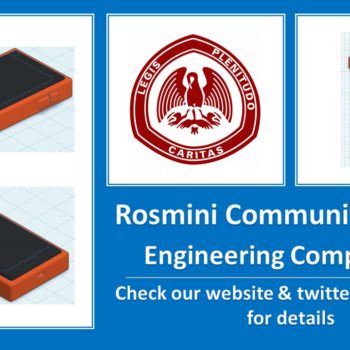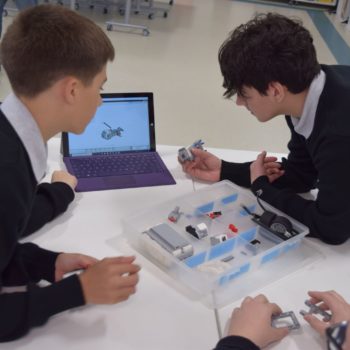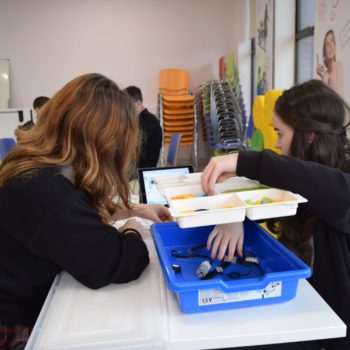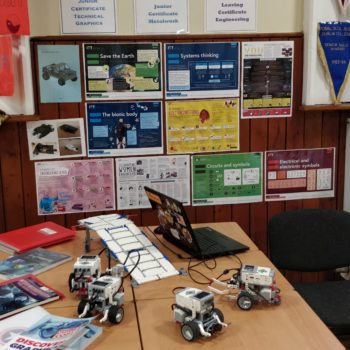ENGINEERING
Engineering is a subject that is offered at Junior Cycle & Senior Cycle.
The subject teacher is Mr Mc Namara; who has several years experience working as an Engineer and then teaching Engineering in our school. His initial qualification is in Manufacturing Engineering, he then specialised in Design Engineering and worked for a number of years as a Design Engineer for an electronics company. Following a change in career, he went back to college to study teaching and we have been lucky to have him in our staff since then. He is very passionate about his subject area and has great knowledge that fosters great interest and enthusiasm among his students.
What is Engineering?
Engineering is the application of scientific knowledge to solving problems in the real world. While science (physics, chemistry, biology, etc.) allows us to gain an understanding of the World and the Universe, Engineering enables this understanding to come to life through problem solving, designing and building things. The electronic device you are using to read this article was engineered from raw plastic, metal, silicon and lines of software code before being transformed into a usable device.
Engineers can be distinguished from other professions by their ability to solve complex problems and implement solutions in cost effective and practical ways. This ability to face a problem, work through various thoughts and abstract ideas and then translating them into reality is what is so exciting about engineering.
Junior Cycle Engineering
The study of junior cycle Engineering aims to:
- enable students to develop the disciplinary skills and knowledge to engineer an end product
- enable students to engage in goal-oriented problem solving, creating an awareness of
- engineering processes
- develop the necessary skills and apply engineering processes to manipulate material to
- manufacture a product with efficiency, accuracy, precision and a high-quality finish
- develop an engineering mindset through the exploration of contemporary engineering
- developments.
Junior Cycle Key Skills
| Key skills | Key skill elements | Examples of student learning activities |
| Being creative | Exploring options and alternative | Students will research alternative technologies to perform operations. |
| Being literate | Expressing ideas clearly and accurately | Students will select the most appropriate media to communicate their ideas/solutions. |
| Being numerate | Expressing ideas mathematically | Students will use correct mathematical notation when communicating dimensions. |
| Communicating | Using language | Students will demonstrate correct technical language when explaining a process and presenting ideas. |
| Managing information and thinking | Thinking creatively and critically | Students will engage in innovative thinking in designing solutions and critique their solution based on the needs related to the problem. |
| Managing myself | Setting and achieving personal goals | Students will establish a plan of work and apply it to the creation of a project. |
| Staying well | Being positive about learning | Students will be encouraged to develop a curiosity about the multi-disciplines of engineering and a positive outlook on the subject. |
| Working with others | Co-operating | Students will collaborate to design and build engineering solutions. |
Engineering focuses on developing students’ understanding of, and skills in, the applications and impact of technologies in the world around them. This will be achieved through three interconnected contextual strands: Processes and principles, Design application and Mechatronics.
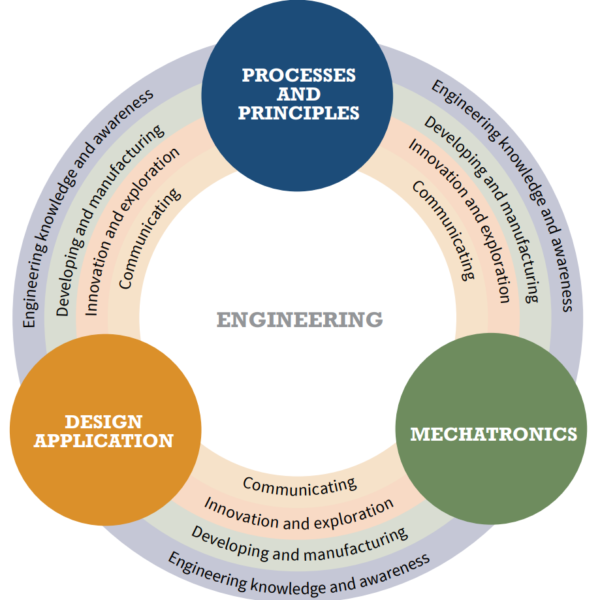 Processes & Principles
Processes & Principles
In this strand, students will learn about and employ the fundamental processes and principles of engineering. Students will apply their knowledge of materials and equipment to design and manufacture products.
Students will be encouraged to use the engineering principles and processes, together with accuracy and precision, to help develop an engineering ‘mindset’ which ultimately leads to the production of innovative and efficient solutions of high quality and finish.
Design Application
In this strand, students will learn about the key stages of the engineering design process. They will understand the importance of design in both the end-user experience and the economic and social impact of the product.
They will discover how informed choice of materials and processes combine to produce a solution that is functional and efficient. Students will learn the value of good project management and how to manage themselves and the product development through the journey from the design to the manufacture stage.
Mechatronics
In this strand, students will use a combination of mechanical, manufacturing, electronic and software engineering to explore the relationship between simple inputs, processes and outputs. Mechatronics engages students in learning how high-tech manufacturing is performed and why it is becoming one of the fastest-growing career areas. Students will develop an appreciation of how control systems operate on a much larger scale and consider how the design of control systems can impact positively on the environment and sustainability. They will appreciate the role that Engineering can play in employing ‘systems thinking’ to design products and services that contribute to a better future.
Throughout each of the strands, the use of four elements: Engineering knowledge and awareness, Innovation and exploration, Developing and manufacturing and Communicating creates a framework for learning that ensures a coherent learning experience for the students.
Element 1: Engineering knowledge and awareness
The learning outcomes in this element are designed to raise student awareness and develop knowledge of relevant engineering principles and developments. Students will learn how to use the materials and equipment available to them in Engineering to inform their decisions about material and resource selection to engineer a product or solution.
Element 2: Innovation and exploration
In this element, the learning outcomes encourage students to explore the applications of engineering in the world around them. Students research existing and emerging developments and gain an appreciation of their impact and potential application to an engineered product.
Element 3: Developing and manufacturing
In this element, the learning outcomes develop the student’s abilities to produce products and solutions through various materials. Students combine their learning from other elements to engineer products to a high, functional standard. The key focus is on efficiency, accuracy, precision and high-quality finish.
Element 4: Communicating
Throughout this element, the learning outcomes encourage students to communicate, through appropriate media, to relay technical information, design ideas and the impact engineering has on the environment around them.
Engineering uses an interdisciplinary approach which encourages the integration of the three strands in the teaching and learning of the subject. It has been designed for a minimum of 200 hours of timetabled student engagement across the three years of junior cycle.
This specification aims to maintain a balance between depth and breadth in the study of the subject. This affords a certain amount of flexibility and freedom for teachers to facilitate learning in a way that reflects students’ own choices, their curiosity and their creativity. The achievement of learning outcomes should be planned in a way that is active and stimulating.
Progression from primary to senior cycle
Primary curriculum
While Engineering is not a stand-alone subject or area within the Primary School Curriculum, through its strands, elements and outcomes, Engineering at junior cycle can progress related learning that has taken place at primary level.
A number of subjects in the primary curriculum such as science, mathematics and Visual Arts make reference to the development of problem-solving skills which are key skills for a student of Engineering. Throughout their years at primary school, learners engage in various activities that develop their creativity. They are also developing their fine motor skills, accuracy and spatial reasoning, all of which lend themselves directly to the study of Engineering.
Senior cycle
The study of Engineering at junior cycle develops the foundations for a student to continue their studies in the suite of technology subjects in both the Leaving Certificate and Leaving Certificate Applied programmes.
The subject Engineering is available in both the Leaving Certificate and Leaving Certificate Applied programmes. The learning outcomes in Engineering at junior cycle have strong links to the aims of both subjects. Engineering introduces some of the components of Leaving Certificate Computer Science, particularly strand 3, Mechatronics. The activities students engage in during junior cycle aim to develop a technological student who should be able to adapt themselves to any discipline related to the technology subjects at senior cycle.
The assessment of Engineering for the purposes of the Junior Cycle Profile of Achievement (JCPA) will comprise of:
- two Classroom-Based Assessments: Engineering in action, and Research and development
- a project
- a written examination.
Assessment overview
| CBA 1: Engineering in action | The teacher’s judgement is recorded for the purpose of subject learning and assessment review, and for the school’s reporting to parents and students. The CBA will be completed within a three-week period during term two of second year. |
| CBA 2: Research and development | The teacher’s judgement is recorded for the purpose of subject learning and assessment review, and for the school’s reporting to parents and students. This CBA will inform the student’s work under the Project assessment. The CBA will be completed within a three-week period during term one of third year. |
| Project (70%) | Will be specified and marked by the State Examinations Commission annually. |
| Written examination (30%) | Set and marked by State Examinations Commission. |

